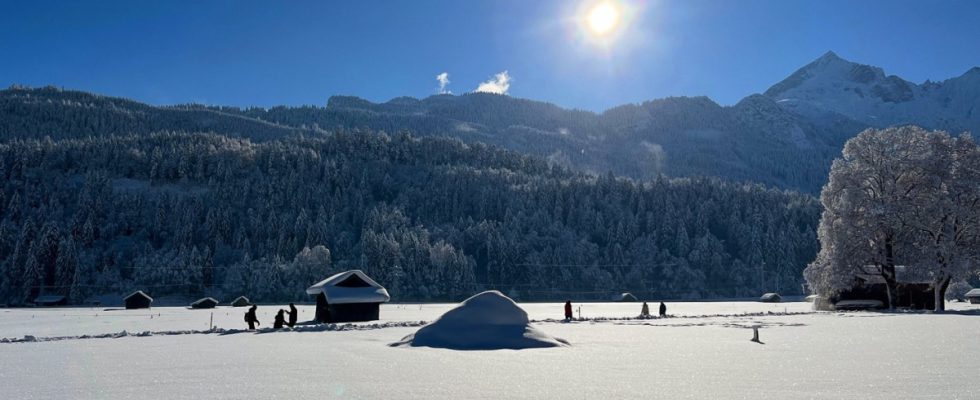The first weekend of Advent began with snow chaos in the south of Bavaria and brought with it the most beautiful winter weather on Sunday. Traffic in and around Munich in particular was initially severely affected by the heavy snowfall, and the airport and main train station were temporarily paralyzed. But the weather also affected traffic elsewhere.
There were power outages in parts of Bavaria due to fallen trees. A spokesman for network operator Bayernwerk said on Saturday that “many thousands” of households were affected, particularly in the areas of Penzberg, Kolbermoor, Freilassing, Parsberg, Vilshofen, Eggenfelden and Regen. On Sunday, the power supply was largely restored throughout Bavaria.
One problem in some areas was the weight of all the fresh snow on the roofs. In Straubing, for example, the roof of the ice stadium had to be cleared of snow on Saturday evening. In Weilheim, almost 70 residents were taken out of an apartment building that was in danger of collapsing due to the masses of snow.
The community of Jachenau remained cut off from the outside world because both the road from the Isar valley and the toll road from Walchensee were closed. The mountain rescue service had a vehicle with snow chains ready to transport patients. As the Interior Ministry announced, a police helicopter was used there on Sunday morning to clear the trees of snow using the downdraft of the rotors. This should eliminate the risk of snow breakage and make clearing work possible without risk.
In Windberg in the Straubing-Bogen district, a driver struggles through the snow on Saturday.
(Photo: Armin Weigel/dpa)

In Landsberg am Lech, a tree could not withstand the snow load.
(Photo: Karl-Josef Hildenbrand/dpa)

Shoveling snow was also popular in the Swabian town of Kaufbeuren.
(Photo: Karl-Josef Hildenbrand/dpa)
Elsewhere in southern Bavaria, traffic also returned to normal on Sunday night. The authorities only reported minor accidents. “A few trees are still falling, but there were only accidents with sheet metal damage,” said a spokesman for the police headquarters in Rosenheim, which the day before had called on everyone in southern Upper Bavaria to stay at home and otherwise side streets and forest areas to avoid. According to a spokesman, the accident in Lower Bavaria on Sunday was also “typical for the time of year”. According to the police, the night was similarly quiet on the streets in northern Upper Bavaria and Swabia.
On Saturday, Interior Minister Joachim Herrmann (CSU) thanked the thousands of emergency services who had been on duty since Friday night and had helped to clear streets and paths of snow and fallen trees, to evacuate broken down trains and to help with accidents. In view of the high risk of accidents, Herrmann appealed to all road users: “If possible, stay at home in the regions affected by massive snowfall, because every avoidable journey relieves the burden on the emergency services.”
Forestry Minister Michaela Kaniber (CSU) warned on Sunday against entering the forests in southern Bavaria. Falling branches and falling trees pose a great danger. “Many trees can no longer withstand the high load of wet snow in their crowns at the moment and can tip over or collapse without warning. Anyone who doesn’t necessarily have to go into the forest should stay outside in the next few days,” said the minister.
According to Kaniber, the situation is particularly dangerous in the Alps, on the edge of the Alps and in the eastern low mountain ranges. Relief can only be expected once the snow has thawed from the branches.
The train service on the Zugspitze was stopped on Saturday – just one day after the start of the ski season. “We have completely closed the Zugspitze,” said a Zugspitzbahn spokeswoman. Neither the cable car nor the cog railway could run. There is a significant risk of avalanches and there is also broken snow on the cog railway route. Trees had fallen and were blocking the tracks. “The employees didn’t even come up.” The road to the Eibsee to the valley station of the Zugspitz cable car was also difficult to navigate; a bus left the road and slid into the ditch.

On Sunday many people went out in the beautiful winter weather. Like the ski tourer in the Ammergau Alps, in the background the Hörnlehütte and the Zeitberg (1404 meters).
(Photo: Carsten Hoefer/dpa)
On Sunday the situation changed; the weather was perfect for skiing. There were numerous lifts running in the Bavarian ski areas. At least the cable car was back in operation at the Zugspitze. Skiers have been enjoying the fresh snow at Sudelfeld, Spitzingsee and Brauneck since Saturday. Slopes and cross-country trails were also prepared on the Großer Arber in the Bavarian Forest.
In the coming days, meteorologists expect only a few fresh snow in Bavaria, but it is expected to remain cold. The avalanche warning service classified the danger situation along the entire Bavarian Alps as “significant”. For the Mühldorf district, the state education authority decided to replace face-to-face teaching at all public schools with distance learning this Monday.
In the city of Augsburg, 20 schools, including primary and middle schools as well as high schools, will temporarily be completely or partially closed, as the city administration announced on Sunday. The reason is the masses of snow that weigh on the roofs of the buildings. After the snow has melted, the buildings would have to be checked for their statics.

